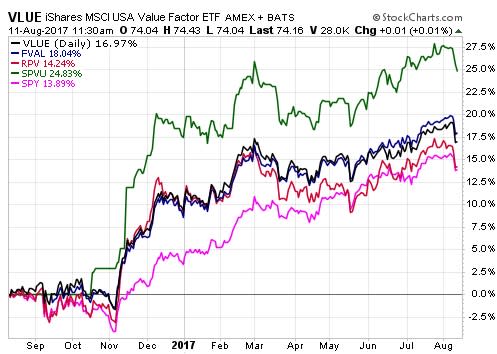ETFs Make Value Investing Easier
This article is part of a regular series of thought leadership pieces from some of the more influential ETF strategists in the money management industry. Today's article features Paula Wieck, portfolio manager at Nebraska-based CLS Investments.
One of the most difficult investment strategies is value investing (buying assets at a price below fair value). Value investing goes against human nature.
When a stock or sector is doing really well, a plethora of positive research becomes available. It’s much more difficult for people in the media (or even professional investment managers) to write positively about something that’s beat up.
To a novice, it can be pretty easy to get wrapped up in the hype of what’s hot. And that leads to buying at a price higher than fair value, an act that can be devastating to future returns.
Bargain Seeking
As value managers, we look for segments of the market that have had poor returns, seeking a bargain. We have to decide when the timing is right, because if it’s wrong, investors will demand an explanation, and may grow impatient with underperformance. Usually, there are perceived drawbacks with value companies. Those warrant closer attention to breaking news, which may further devalue the company.
We as value managers don’t follow the crowd, and we sometimes feel stupid for our contrarian views. A perfect example at CLS is our recent allocation to Spanish equities. We added exposure toward the end of 2015 after Spain equities had lost nearly 16% that year. In 2016, it declined another 2%. It was only this year that the trade paid off, as the region is up more than 27% year-to-date.
As value managers, if we allocate to a position that underperforms, our investors may be tempted to abandon ship and not let the strategy play out. In addition, with the surge of technological innovation, prime stock information is readily and freely available, removing some of our competitive advantages of the past. Yes, value investing is hard. But ETFs make it easier.
ETFs Offer Value Diversification
One value-oriented ETF will often hold well over 100 individual stocks. Of course, we don’t want any of these stocks to go down, but the diversification benefit of holding a basket of stocks adds security. If one or several stocks go under, there are hundreds of others that will not.
While the ETF isn’t going to outperform the best-performing stocks, we lower our overall risk by taking this approach. It works much like a mutual fund, but with greater transparency and flexibility.
The unique characteristics of some smart-beta, value-oriented ETFs also offers another way to diversify portfolios. While traditional, passive-value ETFs offer cap-weighted exposure, one can choose to use the iShares Edge MSCI USA Value Factor ETF (VLUE), which reweights securities in each sector to emphasize value stocks as defined by sales, book value, earnings and cash earnings rather than market prices. This is an effective way for investors to maintain sector exposure of the broad market with a value twist.
The Fidelity Value Factor ETF (FVAL) is similar, except the index uses free cash flow yield, EBITDA [earnings before interest, taxes, depreciation and amortization] to enterprise value, tangible book value to price, and earnings over the next 12 months to price. In addition, the individual stock positions have a weight adjustment that limits concentration in stocks, which could be monopolized by market cap.
Sector weights are nearly identical, but the weight adjustment in FVAL does make a difference. For example, Apple is the top holding in each ETF, but it’s 4% in FVAL, while nearly 10% in VLUE.
For something more pure, which is not sector-constrained, the Guggenheim S&P 500 Pure Value ETF (RPV) or the PowerShares S&P Enhanced 500 Value Portfolio (SPVU) does the trick.
SPVU is more concentrated, but both use book-to-price, earnings-to-price and sales-to-price ratios. While RPV has more of a small/midcap tilt, both are heavy financials and consumer names. These ETFs are ideal for the value manager who wants pure value concentration, either as a core or satellite to his or her portfolio.
All four funds have outperformed the SPDR S&P 500 ETF Trust (SPY) over the last months.

Chart courtesy of StockCharts.com
Other ETF Value Plays
Because the underlying holdings are posted online every day, it’s fairly easy to get various valuation metrics available in aggregate at the ETF level.
If investors prefer to build their own valuation model using different valuation inputs, they could aggregate the various metrics into a customized composite score and screen the ETF universe accordingly.
It makes for an interesting way to rotate between sectors, regions and other segments of the market fairly efficiently. As another example, if investors are looking for European exposure because they find the economic and policy environment promising, they can select more granular value exposure by screening for various value metrics for all the country ETFs available within Europe.
This is how we selected our position in Spain at the end of 2015. Spain was far more undervalued than the rest of developed Europe, so its returns have had more “bang for the buck” as the region recovered.
ETFs make value investing easier, especially in a challenging environment with ample information available and high market valuations.
At the time of writing, CLS Investments held positions in SPY, VLUE, FVAL and RPV. CLS Investments is a third-party investment manager and ETF strategist. It began to emphasize ETFs in individual investor portfolios in 2002, and is now one of the largest active money managers using exchange-traded funds. Contact CLS’ Portfolio Manager Paula Wieck at 402-896-7001 or at paula.wieck@clsinvest.com. Please click here for a complete list of relevant disclosures and definitions.
2850-CLS-8/16/2017
Recommended Stories

 Yahoo Finance
Yahoo Finance 